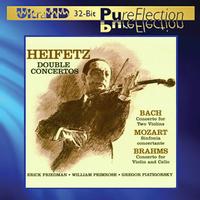Jascha Heifetz - Bach/Mozart/Brahms: Double Concertos
(First 1000 Numbered Limited)
| Label: |
Sony |
| Genre: |
Classical |
| Product No.: |
CSON 6414
|
| UPC: | 888837641425 |
| Availability: |
Back Ordered
|
| Category: |
Ultra HD |
This item is Back Ordered and currently unavailable.
Please inform me of any status changes for this product regarding its upcoming availability.
Numbered, limited edition Ultra High Definition 32-bit mastering import CD
This album includes double concertos by Bach, Mozart and Brahms performed by the highly talented violinist, Jascha Heifetz.
The Concerto for 2 Violins, Strings and Continuo in D Minor, BWV 1043, also known as the Double Violin Concerto or "Bach Double", is perhaps one of the most famous works by J. S. Bach and considered among the best examples of the work of the late Baroque period. Bach wrote it between 1717 and 1723 when he was the capellmeister at the court of Anhalt-Köthen, Germany. The concerto is characterized by the subtle yet expressive relationship between the violins throughout the work. The musical structure of this piece uses fugal imitation and much counterpoint.
The Sinfonia Concertante for Violin, Viola and Orchestra in E-flat major, K. 364 (320d), was written by Wolfgang Amadeus Mozart. At the time of its composition in 1779, Mozart was on a tour of Europe that included Mannheim and Paris. The composition's complex orchestral dynamics reflects the increasing technical competence of the European orchestra of that era and was strongly influenced by the Chevalier de Saint-George; whom he met while in Paris and whose Concerto for Violin and Orchestra Op. 5, No. 2 Mozart quoted in the final movement; as well as by Mozart's visit to the Mannheim court orchestra during his European tour of 1777 to 1779. Mozart had been experimenting with the sinfonia concertante genre and this work can be considered his most successful realization in this cross-over genre between symphony and concerto.
The Double Concerto in A minor, Op. 102, by Johannes Brahms is a concerto for violin, cello and orchestra. The Double Concerto was Brahms' final work for orchestra. It was composed in the summer of 1887, and first performed on 18 October of that year in the Gürzenich in Köln, Germany. Brahms approached the project with anxiety over writing for instruments that were not his own. He wrote it for the cellist Robert Hausmann, a frequent chamber music collaborator, and his old but estranged friend, the violinist Joseph Joachim. The concerto was, in part, a gesture of reconciliation towards Joachim, after their long friendship had ruptured following Joachim's divorce from his wife Amalie.(Brahms had sided with Amalie in the dispute.)
The concerto makes use of the musical motif A-E-F, a permutation of F-A-E, which stood for a personal motto of Joachim, Frei aber einsam ("free but lonely"). Thirty-four years earlier, Brahms had been involved in a collaborative work using the F-A-E motif in tribute to Joachim: the F-A-E Sonata of 1853.
Mastered by the Ultra High Definition 32-Bit Mastering process, a proprietary ultra-high-quality mastering system. This leading-edge system reproduces as closely as possible the sound of the original master tape! Playable on all CD Players.
| Johann Sebastian Bach (1685 - 1750) | Concerto in D Minor for Two Violins, BWV 1043 | Vivace | Largo ma non tanto | Allegro | Wolfgang Amadeus Mozart (1756 - 1791) |
Sinfonia concertante in E-Flat, K. 364 | Allegro maestoso | Andante | Presto | Johannes Brahms (1833 - 1897) |
Concerto in A Minor for Violin and Cello, Op. 102 | Allegro | Andante | Vivace non troppo |
|
View other items by Jascha Heifetz |
|
 In-Stock Music Orders Over $99 SHIP FREE Within The Continental U.S.
In-Stock Music Orders Over $99 SHIP FREE Within The Continental U.S.







 Login
Login
 My Account
My Account
 Cart
Cart Wishlist
Wishlist
 Contact
Contact





